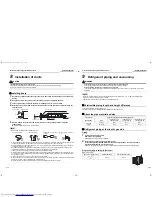
Air to Air Heat Exchanger with DX Coil Unit
Installation Manual
Air to Air Heat Exchanger with DX Coil Unit
Installation Manual
– 6 –
EN
Installation in high-humidity
places
• Do not use the unit in a kitchen or bathroom.
If the unit is used in a place where much oil smoke is
generated or a place with high humidity, the filter or the
heat exchanging element will become clogged and the
unit will not work.
• Be careful of dewing and frosting.
• In cold regions, the surface of the unit or the duct
connector may be affected by condensation or
frosting depending on the outdoor air conditions or
temperature / humidity of the ceiling cavity even
though the conditions for use are observed. In this
case, add a heat insulator.
• Water droplets may fall if the unit is operated in
wet conditions.
In particular, high humidity may occur even during
non-rainy season if the unit is installed in the
following locations:
1. Ceiling of a tile roof
2. Ceiling of a slate roof
In this case, attach thermal insulators (glass
wool, etc.) on the unit’s surface.
Take care so that you can remove the side board
(service panel) easily even when insulators are
attached.
Also insulate the duct and its connectors
sufficiently.
• Do not install the unit in a place where there is
something that must not become wet. Depending
on the temperature or humidity of outdoor air and
the installation place, water droplets may fall from
the unit.
• As shown in the figure to the below, suppose a
high temp absorbing air condition A and a low
temp absorbing air condition B are plotted on the
air line figure, then a high temp air A is heat-
exchanged by the unit and goes out of the
saturation curve as shown by Point C. In this case,
the unit will be dewed or frosted. To avoid this,
heating a low temp air B up to B’ is required so as
to get C’ below the saturation curve, before using
the unit.
• Do not install the unit near a water heater.
A
B
C
C'
B'
Dry-bulb temperature (°C)
A
bso
lu
te
hu
m
id
ity (
kg
/kg
’)
S
at
ur
at
io
n
C
ur
ve
5
Installation of indoor unit
WARNING
•
Install the air conditioner at enough strong place to withstand the weight of the unit.
If the strength is not enough, the unit may fall down resulting in injury.
•
To provide against strong wind or an earthquake, install the unit appropriately.
Inappropriate installation may result in the unit falling down and causing an accident.
NOTE
Strictly comply with the following rules to prevent damage of the indoor units
and human injury.
• Do not put a heavy article on the indoor unit. (Even units are packaged)
• Carry in the indoor unit as it is packaged if possible. If carrying in the indoor unit
unpacked by necessity, be sure to use buffering cloth, etc. to not damage the unit.
• To move the indoor unit, hold the hooking metals (4 positions) only.
Do not apply force to the other parts (refrigerant pipe, drain pan, foamed parts, or
resin parts, etc.).
Before you handle hanging brackets, put on thick gloves for protection.
• Supplied accessories are placed near the electrical control box. Do not dispose
of the accessories with the packaging. (See the figure on the right.)
• When a vibration-proof hanging bracket is attached to a hanging bolt, confirm that the unit does not vibrate more
through using the vibration-proof hanging bracket.
• Use a forklift to carry the unit. As it is packed in a cardboard box, do not drag or push it.
• Suction duct length must be longer than 850 mm.
• Helmet must be worn to protect your head from falling objects.
Especially, when you work under an inspection opening, helmet must be worn to protect your head from falling
objects from the opening.
External dimensions
Box for supplied
accessories
SA
(Supply air)
RA
(Return air)
EA
(Exhaust air)
OA
(Outdoor air)
40
0
G
J
A
D
K
80
0
ØI
ØH
40
0
D
B
C
550
F
E
E
43
0
E
E
Maintenance cover
Inspection cover
Electrical control cover
11-EN
12-EN
+00ET99805001-2.book Page 6 Tuesday, July 26, 2011 1:39 PM








































